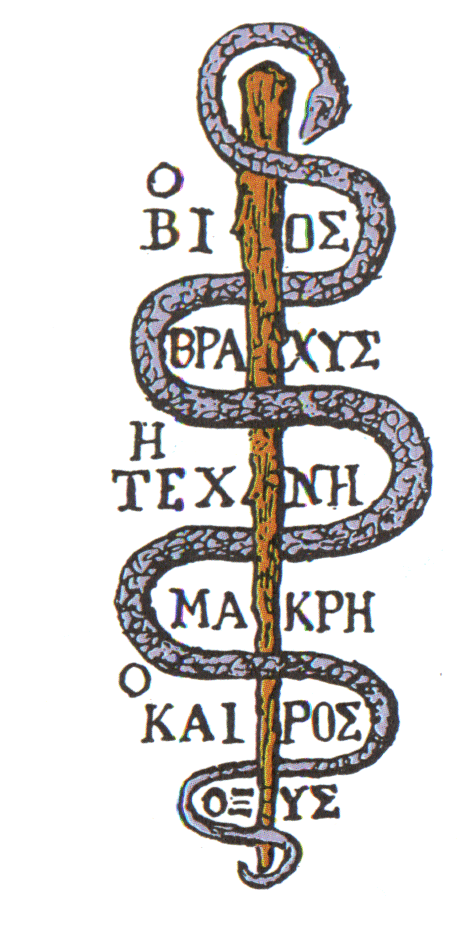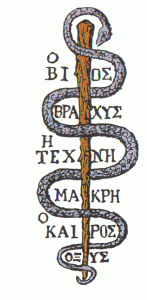By Hannah Hoag & Kasra Hassani
Health, Medicine and Veterinary Science subject editors
Birth, death and everything in between. That just about sums up the blogs housed within the Health, Medicine and Veterinary science category. There’s a solid roster of writers here with some serious creds. Since this is the first Editor’s post for the category, we thought we’d start by highlighting some of the blogs and the issues they cover (and here’s a bit about why the symbol of medicine is a couple of snakes on a stick, the Cauduceus).
Oh, baby!
Before she became the mother of three, Kathleen Couillard, aka Maman Éprouvette (Test-tube Mommy), was a microbiologist. She left the lab to raise her children, but she never lost her passion for science. In fact, motherhood opened up a whole new field for her. Today she writes about the science of pregnancy and the perinatal period. In early December, she posted on “natural” cesareans, an alternate approach to cesarean delivery to improve a woman’s satisfaction with the surgical procedure. It slows down the baby’s delivery through the abdominal incision and establishes early skin-to-skin contact. On Mondays, she answers readers’ questions, such as “What happens to maternal-antibody levels during weaning?” She’s prolific, too, so you’re apt to find the answers to all your beginning-of-life questions here. Oh, and it’s all in French, but Google translate can help you with that.
Staying with the motherhood theme for a moment: over at the Science of Eating Disorders blog, Andrea posted on the perspectives of mothers with eating disorders. This multi-authored blog gives many perspectives on eating disorders, with all the bloggers writing about peer-reviewed research in the field. Tetyana Pekar, the neuroscientist who started it, wants to make the mountain of academic research accessible to the public. It’s a lively blog, where researchers, students, and the public comment on media influence, double lives, and whether insurance companies should pay for residential treatment of eating disorders, which can cost $1,000 per day.
Maize-gate
Recent weeks saw another flashpoint in the debate over the safety of genetically modified (GM) agricultural products, with retraction of an (in)famous paper. Seralini et al. published a study in September 2012 in Food and Chemical Toxicology claiming that GM maize causes cancer in rats. This study was highly criticized for being inconclusive and not scientifically sound, and contested not just by scientists and science bloggers, but also by the European Food Safety Authority.
Following more than a year of debate and controversy, the journal retracted Seralini’s paper last month. Canadian scientist and blogger Cami Ryan writes frequently about genetic engineering and agriculture, and has extensively discussed the debate on GM food and the public’s perception of genetic engineering in agriculture: its safety, economic value, the science behind it and so on. Most interesting to us were her original post on Seralini’s paper, I smell a rat, which came out right after the publication of the study in September 2012, and her retraction reaction, including a comprehensive list of organisations, scientists and authorities that had discredited the study.
More on the science of GMO production, Genome Alberta’s blog, LiveStock, has interesting posts on the importance and potential benefits of genetic engineering in food and livestock production. Read our favourite posts here and here.
Bookmark these
FrogHeart and Obesity Panacea are two other Canadian blogs that have been on our reading lists long before Science Borealis took flight. FrogHeart pegs itself as a blog about nanotechnology, science policy, communication, society and the arts. It’s our go-to destination to catch up on the latest juicy Canadian science policy and innovation chatter. The authors at Obesity Panacea, hosted over at PLoS Blogs, cut down questionable weight-loss gimmicks with the sword of evidence.
So here are some prominent examples of what you can find in the Health, Medicine and Veterinary Medicine section of Science Borealis. Of course there is a lot more left to explore, and we encourage our readers to skim through the variety and read about issues of interest to them!






The symbol of medicine is not the Caduceus (the staff of Hermes). The link you provide points out as much. The two snake staff was incorrectly selected by the US Medical Corps. Some US medical institutions do use the caduceus, perhaps thinking that two snakes are better than one?!
However, it’s not a snake in the correct symbol, the Rod of Asclepius, which is in the picture you show. It’s a Guinea worm – a parasitic nematode. Thanks to efforts from many, including the Carter Center, may soon be eradication, the first parasite for which this is true. Exciting times!
I admit that “worm on a stick” doesn’t have the same ring to it.